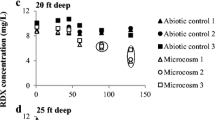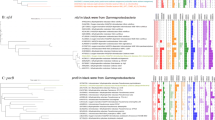Abstract
A small-scale functional gene array containing 15 functional gene probes targeting aliphatic and aromatic hydrocarbon biodegradation pathways was used to investigate the effect of a pilot-scale air sparging and nutrient infiltration treatment on hydrocarbon biodegradation in creosote-contaminated groundwater. Genes involved in the different phases of polycyclic aromatic hydrocarbon (PAH) biodegradation were detected with the functional gene array in the contaminant plume, thus indicating the presence of intrinsic biodegradation potential. However, the low aerobic fluorescein diacetate hydrolysis, the polymerase chain reaction (PCR) amplification of 16S rRNA genes closely similar to sulphate-reducing and denitrifying bacteria and the negligible decrease in contaminant concentrations showed that aerobic PAH biodegradation was limited in the anoxic groundwater. Increased abundance of PAH biodegradation genes was detected by functional gene array in the monitoring well located at the rear end of the biostimulated area, which indicated that air sparging and nutrient infiltration enhanced the intrinsic, aerobic PAH biodegradation. Furthermore, ten times higher naphthalene dioxygenase gene copy numbers were detected by real-time PCR in the biostimulated area, which was in good agreement with the functional gene array data. As a result, functional gene array analysis was demonstrated to provide a potential tool for evaluating the efficiency of the bioremediation treatment for enhancing hydrocarbon biodegradation in field-scale applications.





Similar content being viewed by others
References
Alef K (1995) Estimation of the hydrolysis of fluorescein diacetate. In: Alef K, Nannipieri P (eds) Methods in applied soil microbiology and biochemistry, 3rd edn. Academic, London, UK, pp 232–233
Amann RI, Ludwig W, Schleifer KH (1995) Phylogenetic identification and in situ detection of individual microbial cells without cultivation. Microbiol Rev 59:143–169
Anderson RT, Lovley DR (1997) Ecology and biochemistry of in situ groundwater bioremediation. Adv Microb Ecol 15:289–350
Bakermans C, Madsen EL (2002) Diversity of 16S rDNA and naphthalene dioxygenase genes from coal-tar-waste-contaminated aquifer waters. Microb Ecol 44:95–106
Bakermans C, Hohnstock-Ashe AM, Padmanabhan S, Padmanabhan P, Madsen EL (2002) Geochemical and physiological evidence for mixed aerobic and anaerobic field biodegradation of coal tar waste by subsurface microbial communities. Microb Ecol 44:107–117
Baldwin BR, Nakatsu CH, Nies L (2008) Enumeration of aromatic oxygenase genes to evaluate monitored natural attenuation at gasoline-contaminated sites. Water Res 42:723–731
Cavalca L, Dell’Amico E, Andreoni V (2004) Intrinsic bioremediability of an aromatic hydrocarbon-polluted groundwater: diversity of bacterial population and toluene monoxygenase genes. Appl Microbiol Biotechnol 64:576–587
Cerniglia CE (1984) Microbial metabolism of polycyclic aromatic hydrocarbons. Adv Appl Microbiol 30:31–71
Denef VJ, Park J, Rodrigues JL, Tsoi TV, Hashsham SA, Tiedje JM (2003) Validation of a more sensitive method for using spotted oligonucleotide DNA microarrays for functional genomics studies on bacterial communities. Environ Microbiol 5:933–943
Gentry TJ, Wickham GS, Schadt CW, He Z, Zhou J (2006) Microarray applications in microbial ecology research. Microb Ecol 52:159–175
Ferguson AS, Huang WE, Lawson KA, Doherty R, Gibert O, Dickson KW, Whiteley AS, Kulakov LA, Thompson IP, Kalin RM, Larkin MJ (2007) Microbial analysis of soil and groundwater from a gasworks site and comparison with a sequenced biological reactive barrier remediation process. J Appl Microbiol 102:1227–1238
He Z, Gentry TJ, Schadt CW, Wu L, Liebich J, Chong SC, Huang Z, Wu W, Gu B, Jardine P, Criddle C, Zhou J (2007) GeoChip: a comprehensive microarray for investigating biochemical, ecological and environmental processes. ISME J 1:67–77
Iwai S, Kurisu F, Urakawa H, Yagi O, Kasuga I, Furumai H (2008) Development of an oligonucleotide microarray to detect di- and monooxygenase genes for benzene degradation in soil. FEMS Microbiol Lett 285:111–121
Jeon CO, Park M, Ro HS, Park W, Madsen EL (2006) The naphthalene catabolic (nag) genes of Polaromonas naphthalenivorans CJ2: evolutionary implications for two gene clusters and novel regulatory control. Appl Environ Microbiol 72:1086–1095
Johnsen AR, Karlson U (2005) PAH degradation capacity of soil microbial communities—does it depend on PAH exposure? Microb Ecol 50:488–495
Kepner RL, Pratt JR (1994) Use of fluorochromes for direct enumeration of total bacteria in environmental samples: past and present. Microbiol Rev 58:603–615
Leahy JG, Colwell RR (1990) Microbial degradation of hydrocarbons in the environment. Microbiol Rev 54:305–315
Liao P, Chen T, Chung P (2001) A fast algorithm for multilevel thresholding. J Inf Sci Eng 17:713–727
Muyzer G, de Waal EC, Uitterlinden AG (1993) Profiling complex microbial populations by denaturing gradient gel electrophoresis analysis of polymerase chain reaction-amplified genes coding for 16S rRNA. Appl Environ Microbiol 59:695–700
NRC (1993) In situ bioremediation; when does it work?. National Academy Press, Washington, DC
Nyyssönen M, Piskonen R, Itävaara M (2006) A targeted real-time PCR assay for studying naphthalene degradation in the environment. Microb Ecol 52:533–543
Nyyssönen M, Piskonen R, Itävaara M (2008) Monitoring aromatic hydrocarbon biodegradation by functional marker genes. Environ Pollut 154:192–202
Pearson WR, Lipman DJ (1988) Improved tools for biological sequence comparison. Proc Natl Acad Sci U S A 85:2444–2448
Piskonen R, Itävaara M (2004) Evaluation of chemical pretreatment of contaminated soil for improved PAH bioremediation. Appl Microbiol Biotechnol 65:627–634
Piskonen R, Nyyssönen M, Itävaara M (2005) Monitoring of accelerated naphthalene-biodegradation in a bioaugmented soil slurry. Biodegradation 16:127–134
Piskonen R, Nyyssönen M, Itävaara M (2008) Evaluating the biodegradation of aromatic hydrocarbons by monitoring of several functional genes. Biodegradation 19:883–895
Pulli T, Höyhtyä M, Söderlund H, Takkinen K (2005) One-step homogeneous immunoassay for small analytes. Anal Chem 77:2637–2642
Rhee SK, Liu X, Wu L, Chong SC, Wan X, Zhou J (2004) Detection of genes involved in biodegradation and biotransformation in microbial communities by using 50-mer oligonucleotide microarrays. Appl Environ Microbiol 70:4303–4317
Riser-Roberts E (1998) Remediation of petroleum contaminated soils: biological, physical, and chemical processes. CRC, New York
Ringelberg DB, Talley JW, Perkins EJ, Tucker SG, Luthy RG, Bouwer EJ, Fredrickson HL (2001) Succession of phenotypic, genotypic, and metabolic community characteristics during in vitro bioslurry treatment of polycyclic aromatic hydrocarbon-contaminated sediments. Appl Environ Microbiol 67:1542–1550
Saeed AI, Sharov V, White J, Li J, Liang W, Bhagabati N, Braisted J, Klapa M, Currier T, Thiagarajan M, Sturn A, Snuffin M, Rezantsev A, Popov D, Ryltsov A, Kostukovich E, Borisovsky I, Liu Z, Vinsavich A, Trush V, Quackenbush J (2003) TM4: a free, open-source system for microarray data management and analysis. Biotechniques 34:374–8
Salminen JM, Tuomi PM, Jørgensen KS (2008) Functional gene abundances (nahAc, alkB, xylE) in the assessment of the efficacy of bioremediation. Appl Biochem Biotechnol 151:638–652
SFS (1979) Determination of pH-value of water. Finnish Standards Association, SFS 3021, Helsinki
SFS (1980) Metal content of water, sludge and sediment determined by atomic absorption spectroscopy, atomization in flame. Special guidelines for lead, iron, cadmium, cobalt, copper, nickel and zinc. Finnish Standards Association, SFS 3047, Helsinki
SFS (1994) Water quality. Determination of electrical conductivity (ISO 7888:1985). Finnish Standards Association, SFS 27888, Helsinki
SFS (1997) Water analysis. Guidelines for the determination of total organic carbon (TOC) and dissolved organic carbon (DOC). Finnish Standards Association, SFS 1484, Helsinki
Stephen JR, Chang YJ, Gan YD, Peacock A, Pfiffner SM, Barlecona MJ, White DC, Macnaughton SJ (1999) Microbial characterization of a JP-4 fuel contaminated site using a combined lipid biomarker/PCR-DGGE based approach. Environ Microbiol 1:231–41
Stübner S, Wind T, Conrad R (1998) Sulfur oxidation of in rice field soil: activity, enumeration, isolation and characterization of thiosulfate-oxidizing bacteria. Syst Appl Microbiol 21:569–578
Suzuki MT, Giovannoni SJ (1996) Bias caused by template annealing in the amplification of mixtures of 16S rRNA genes by PCR. Appl Environ Microbiol 62:625–630
Tolker-Nielsen T, Brinch UC, Ragas PC, Andersen JB, Jacobsen CS, Molin S (2000) Development and dynamics of Pseudomonas sp. biofilms. J Bacteriol 182:6482–6489
Tuomi PM, Salminen JM, Jorgensen KS (2004) The abundance of nahAc genes correlates with the 14C-naphthalene mineralization potential in petroleum hydrocarbon-contaminated oxic soil layers. FEMS Microbiol Ecol 51:99–107
Wilson MS, Bakermans C, Madsen EL (1999) In situ, real-time catabolic gene expression: extraction and characterization of naphthalene dioxyegnase mRNA transcripts from groundwater. Appl Environ Microbiol 65:80–87
Wu L, Liu X, Schadt CW, Zhou J (2006) Microarray-based analysis of subnanogram quantities of microbial community DNAs by using whole-community genome amplification. Appl Environ Microbiol 72:4931–4941
Zhou NY, Fuenmayor SL, Williams PA (2001) nag genes of Ralstonia (formerly Pseudomonas) sp. strain U2 encoding enzymes for gentisate catabolism. J Bacteriol 183:700–708
Acknowledgements
This work was supported by the Ekokem Environmental Foundation (Finland). We thank Dr. Kimmo Järvinen from Ramboll Finland Ltd. for site introduction and Dr. Ari Laitinen from Doranova Ltd. for providing technical information on the biostimulation treatment. We also thank the Finnish DNA Microarray Centre for the preparation of the functional gene arrays. Dr. Wolfgang Hillen is thanked for supplying the A. calcoaceticus strain ADP1, Dr. Tim Tolker-Nielsen for providing the fluorescently tagged P. putida strain OUS82, and Dr. Timo Pulli for the morphine-specific Fab fragment cDNA. Marjo Öster we thank for her assistance in the PCR amplification of the dsrA genes.
Author information
Authors and Affiliations
Corresponding author
Electronic supplementary material
Below is the link to the electronic supplementary material.
Table S1
PCR primers and thermal profiles used for the amplification of the gene probes designed in this study (PDF 8 kb)
Fig. S2
Average PAH concentrations in the creosote-contaminated groundwater during treatment by air sparging and nutrient infiltration. The groundwater samples were recovered from monitoring wells BST1 and BST2 located upstream from the biostimulation treatment zone and monitoring wells BST3, BST4 and BST5 located downstream from it (Fig. 1b). The error bars represent standard deviations between three monitoring wells. a PAH (EPA 16), b naphthalene, c fluorene and d phenanthrene (PDF 7 kb)
Table S3
Specificity of gene probes attached on the functional gene array determined by hybridisation with pure bacterial cultures. The average signal intensities and standard deviations were determined from unnormalised hybridisation signals measured from six replicate spots. The standard deviations between replicate spots are presented in parenthesis (PDF 6 kb)
Rights and permissions
About this article
Cite this article
Nyyssönen, M., Kapanen, A., Piskonen, R. et al. Functional genes reveal the intrinsic PAH biodegradation potential in creosote-contaminated groundwater following in situ biostimulation. Appl Microbiol Biotechnol 84, 169–182 (2009). https://doi.org/10.1007/s00253-009-2022-8
Received:
Revised:
Accepted:
Published:
Issue Date:
DOI: https://doi.org/10.1007/s00253-009-2022-8




